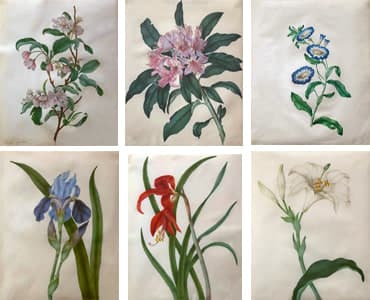Philippa Crabtree
Bearded Iris, Easter Lily, Rhododendron, Aztec Lily, Sweet Pea, and Apple Blossom, late 1700s
Watercolor on vellum
Each work is approximately
11 x 9 inches
27.9 x 22.9 cm
Framed dimensions: 20 1/4 x 18 1/4 inches / each
11 x 9 inches
27.9 x 22.9 cm
Framed dimensions: 20 1/4 x 18 1/4 inches / each
Until the early twentieth century the work of Philippa Crabtree had not been seen for generations, after the exhibition of three of her works at the Royal Academy between 1786...
Until the early twentieth century the work of Philippa Crabtree had not been seen for generations, after the exhibition of three of her works at the Royal Academy between 1786 and 1787. On February 5, 1920, however, a portfolio of drawings on vellum was sold at Messrs. Hodgson in London. The appearance at the same time of works by Elizabeth and Robert Crabtree revealed the existence of a whole artistic family.
The earliest dated drawing by Philippa Crabtree was executed in 1784, and all her other recorded works were completed before the end of the 18th century. The artist illustrated not only common garden plants, but also many exotic varieties that she might have seen at Curtis's London Botanic Garden, a short walk from her home at Bishopsgate.
There were fifty recorded watercolours by the artist, most with the artist's nomenclature, and, as with the present watercolor, the more unusual species are those that remain undated. In 'A Forgotten Botanical Artist: Miss Crabtree' in The Gardeners Chronicle, June 1920, p. 278, W. Roberts speculates that the watercolours which appeared may have been executed for a publication and wonders if any of them were anonymous illustrations for early publications such as the Botanical Magazine.
The earliest dated drawing by Philippa Crabtree was executed in 1784, and all her other recorded works were completed before the end of the 18th century. The artist illustrated not only common garden plants, but also many exotic varieties that she might have seen at Curtis's London Botanic Garden, a short walk from her home at Bishopsgate.
There were fifty recorded watercolours by the artist, most with the artist's nomenclature, and, as with the present watercolor, the more unusual species are those that remain undated. In 'A Forgotten Botanical Artist: Miss Crabtree' in The Gardeners Chronicle, June 1920, p. 278, W. Roberts speculates that the watercolours which appeared may have been executed for a publication and wonders if any of them were anonymous illustrations for early publications such as the Botanical Magazine.
Provenance
Private collection, New YorkPlease join our mailing list
* denotes required fields
We will process the personal data you have supplied in accordance with our privacy policy (available on request). You can unsubscribe or change your preferences at any time by clicking the link in our emails.
